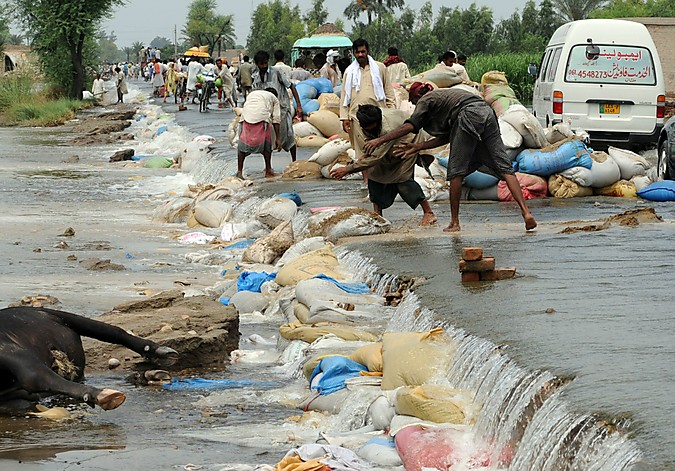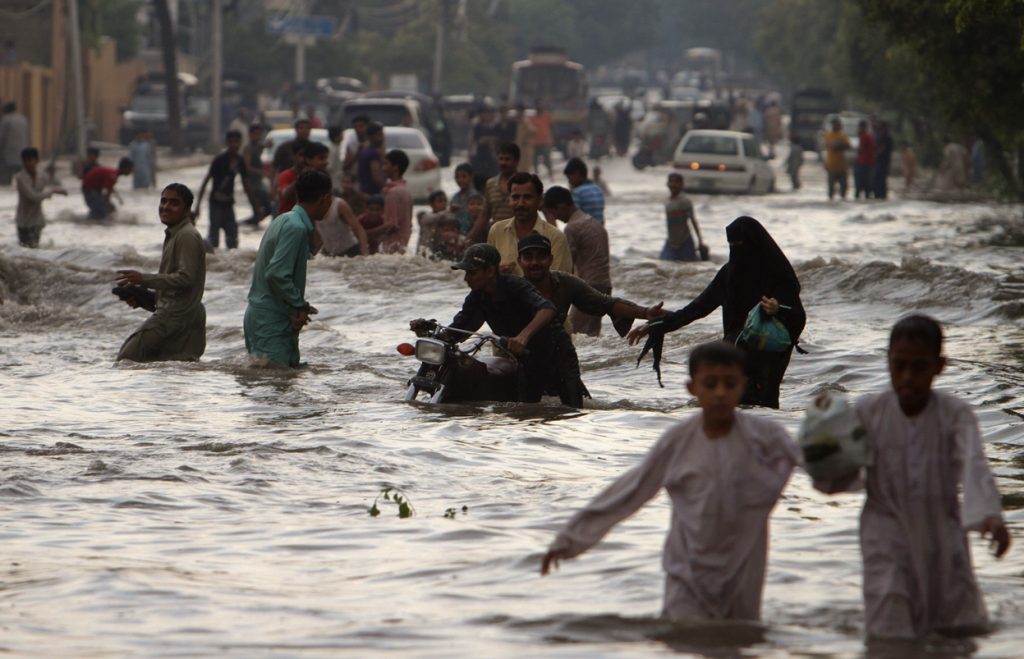Banaras Khan/AFP
By
Zeeshan A. Shah
Global Sea levels have been rising at an alarming rate this century.
Since 1900, the recorded rise in sea levels has been documented at the rate of 0.6 inches per decade but post 1992, recorded levels have seen an increase to 1.2 inches per decade – a significant rise in the last 2000 years. This indicates future surges in tidal flows in coastal regions with high tides and storms.
Scientifically, the three major causes of global sea levels rising are Loss of land-based Ice, Melting of Glaciers and Polar Ice Caps, melting a bit each summer but persistent higher temperatures due to global warming resulting in more than average summer melting. Also diminishing snow falls in the winter have further reduced the ice sheets that used to exist across the planet. Thermal Expansion, another factor is a natural effect that has taken shape. When water warms up, it expands. In the past century we have seen an immense rise in sea levels due to warmer oceans as they simply occupy more space. The oceans are absorbing over 90 percent of the increased atmospheric heat due to fossil fuel emissions and other environmental pollution resulting from human activity. Finally, we are witnessing Ice loss from Greenland and Antarctica where massive ice sheets have melted at an accelerating pace as melted water from above and sea water from below is seeping beneath the ice sheets, melting the core and causing high evaporation at a faster pace than nature anticipated.
Virtually everything is at risk. Roads, Buildings, Subways, Bridges, Power Plants, Water Supplies and all other human infrastructure. Global cities, even entire islands are at risk of being devoured by the ocean as worldwide sea levels are seen to be rising at an average 4 to 8 inches a year, twice the average speed in the past 80 years. Enormous amounts of fossil fuel burning and other human activities have released large amounts of atmospheric gases as the earth temperature rises along with ocean temperatures. Rapid Ocean Rise causes devastation, which includes flooding of wetlands, massive soil erosion, contamination of water aquifers, agriculture plus huge displacement of the human population, destruction of homes and habitats and deaths due to over flooding; severe storms as higher sea levels force them to move or relocate families, homes and businesses.
Globally, eight of the world largest cities in terms of geography and population are coastal cities either surrounded or connected with the ocean. New York is one of them. Similarly Karachi in Pakistan, is also one of them. In the United States, over 40 percent of the population lives in high-population coastal areas. Here, the lives are at risk due to the sea levels that impact flooding, shoreline erosion and storm hazards.
Eco-systems are being adversely affected in the 6th Largest city in the world as temperature rise as birds and animal species have started migrating to higher altitudes due to better optimum temperatures and lots of plants previously found in coastal areas have now become extinct. These changing weather patterns are due to global warming. Aqua life is changing as well. Fishes that were previously found in the deep like the Mackerel species in the Arabian Sea in the last 15-20 years are now being caught and exported by Iran, where they were previously never found.
In 2014, a panel of UN scientists suggested that ocean acidification poses substantial risks to marine life. Man-made carbon-dioxide is released in the air due to burning of fossil fuels forming an weak acid when missed with water than harms fishes. This leads to fishes adjusting their body temperatures every day as CO2 levels peak at night and dip during the day. Hence the fishes surface mostly during the day. All this is partially the result of severe climate change, global warming that is resulting in acidification within the deep seas.
Floods in Karachi, Pakistan – Fareed Khan/AP
Karachi in particular is a classic case in point. There is severe shortage of driunking water in the city and no functional desalination plants in place to convert sea water to fresh water. Plus, rising temperatures are getting dangerous. A few months back, a massive heatwave saw temperatures exceeding 47 to 50% with over 30-50 human deaths due to heat strokes. Mismanagement due to electricity cuts also impeded the progress as pumping of millions of gallons of water could reach the populations causing stress, distress, death and disorder. The issue of overpopulation is also another damaging factor in a city like Karachi. By 2020, the average population of Karachi could end up being as much as the entire population of the country as it was in 1945 as the time of partition. According to the last census conducted in the country, over 4.8 million were not counted for in the population of the Sind Province, where Karachi accounts for 70 percent of the population. As per the Article 51-3 of the constitution, a census is required every 10 years. If the sea levels are rising close to Karachi, any natural disaster like an earthquake or tsunami within the sea can have a horrifying affect.
According to the National Institute of Oceanography in Pakistan, Karachi could drown in the next 35-40 years. Parts of the city like Malir have already sunk and over 30-40 million people could be displaced due to climate change. With sea levels rising by 6 millimeters annually, experts claim that the biggest threat to the city is not terrorism but climate change. In 1945, a Tsunami hit Karachi and if a similar catastrophic event takes place in future, it is feared that unimaginable. Unplanned development in coastal areas of Karachi, illegal construction of factories polluting ocean floors and changing weather patterns may lead to the sinking of Karachi by 2060.
The deep end of the ocean is the danger we face today. If we fail to control the impacts of global warming, rising temperatures will make ocean levels rise up 50 mm or 5 cm up from the present levels and that could mean absolute danger for the citiy and its population of over 20 million people. This year the temperatures rose up to 47% and expected temperature to further rise by the average 3 degrees crossing the 50 degree mark. In and around Karachi, over 3.5 million acres of agricultural ladn has been eroded since 1956. These are extremely dangerous signs.
The next war will be over water, global warming and climate change. Karachi has to be saved from colossal damage and destruction and so does the rest of the country. The Environment has to be the key agenda of the government if they were to meet any goals, whether SDGs or MDGs. But beyond that , a more important goal remains to be the survival of the species; the people of Pakistan.




I didn't realize the oceans were rising so much. I hadn't thought about how water expands when it is heated, but that would explain a lot of it. It's a good thing I don't live on the coast, but this is still a serious issue!